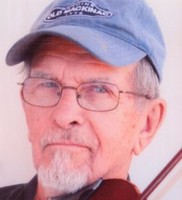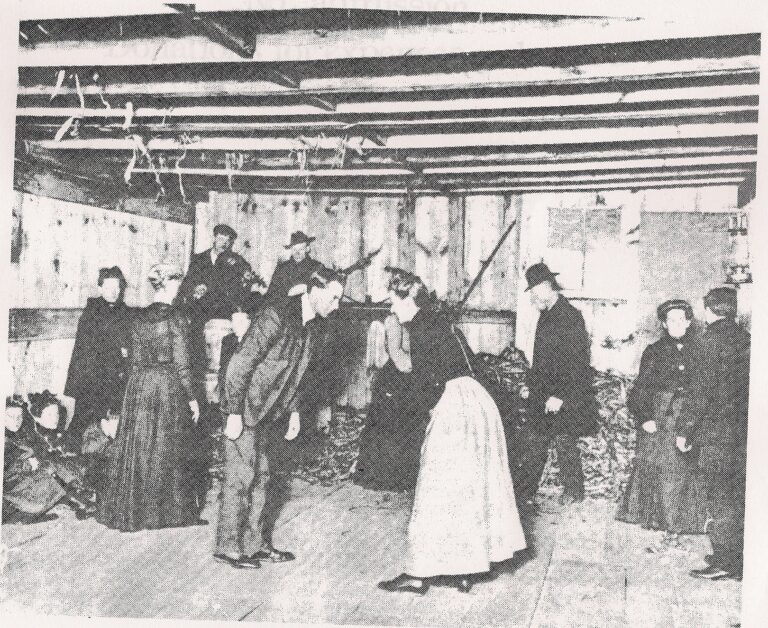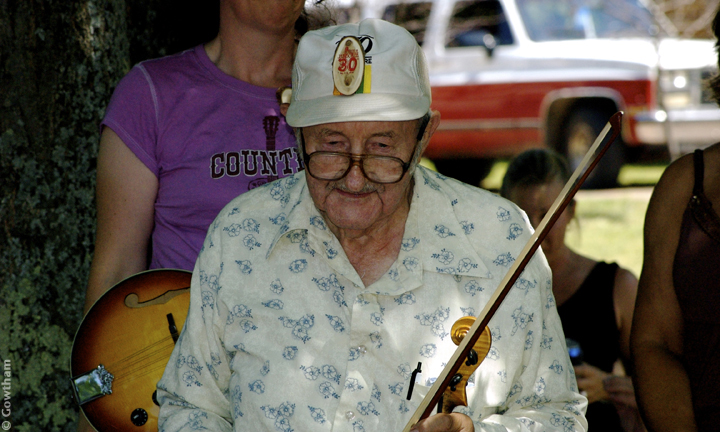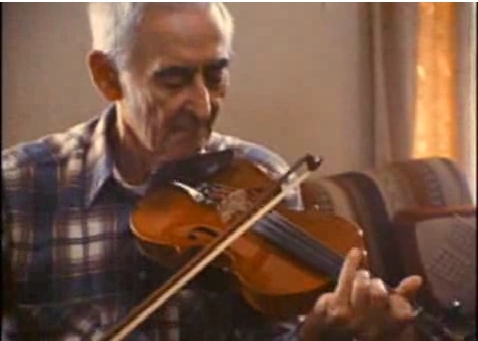
Billy Sparrow
Jig, by Bill Sparrow, 1988
“Climbing Up Them Golden Stairs,” Bill Sparrow, 1988
By Jim McKinney When John Freeman was in town in early December, he gave me what he described as ?David Park Williams? original cassette recordings he had made when Bill Sparrow was moving to Florida and would no longer be able to play for him.? They were recorded in 1988, one tune per tape; the A side with David?s calling and the B side without. Bill?s playing is pretty interesting and I thought you might like to put some up on your website. I?m sending two of the tracks via email along with David Park Williams? notes on the recordings and Bill Sparrow?s bio from 25 Years of Fiddling from the OMFA. Billy?s 6/8 Number is a unique version of Les Raber?s Jig in A in the key of D with a key change to A in the B part. Climbing Up Them Golden Stairs is typical of the way Bill backed up the calling on David Park Williams? cassettes. — Jim McKinney
From 25 Years of Fiddling: Original Michigan Fiddlers, Original Michigan Fiddlers Association, 2001
Bill J. Sparrow
I was born in Ypsilanti, Michigan on March 25, 1923. I am retired from Ford Motor Co. I now live in Ocquoec, Michigan and spend the winter in Zephyr Hills, Florida. Dottie and I also spend time in Allendale, Michigan. My father was a fiddler and I would play with his fiddle. At age 6, I began taking fiddle lessons from Mrs. Moffit. I played left-handed and my teacher had to teach me to play right handed.
At age 11, I began attending school sponsored by Henry Ford. My dad worked on the Ford Farms where they raised soybeans. Mr. Ford had several farms in an area of about 60 miles circumference. The kids whose fathers worked on the Ford Farms attended these schools. There were about 20 of these schools. I attended the Willow Run school. We were taught out of the old McGuffey readers. Mr. Ford would come out to the schools to visit. He was very much into the Early American dance music; he promoted it and it was taught at the schools he owned. Mr. Perry [Clayton Perry], a fiddler, and his group came to the schools to teach dancing. Mr. Lovett [Benjamin Lovett] was the caller for square dancing.
One day, Mr. Ford came out to the Willow Run school and had me play the fiddle for him. I played my dad?s fiddle, which, needless to say, was too big for me. Mr. Ford asked Mr. Perry to bring him a ½ size fiddle and to give me ½ hour lessons weekly, before the dancing lessons. This is how I learned to play all the dance tunes, gavottes, heel & toe, polka, square dances, etc.
This was the beginning of my learning the fiddle.
I feel very fortunate that Mr. Ford was so gracious and kind. After I left school, I played music around the Ypsi area until I retired.
While living in Florida during the winter, I met Dot and we were married December 25, 1999. We play music for ice cream socials, potlucks, dances, etc. in Michigan and Florida. Music and fiddling has been a great part of my life. I thank Mr. Ford and Mr. Perry for my success in music.
I also play saxophone and some banjo. My favorite fiddle tune is ?When It?s Springtime In The Rockies? because it is the first fiddle tune I learned to play.
I joined the OMFA in 1991.
From Mostly Singing Quadrilles: A Note On The Recordings, David Park Williams, 1988
The great Michigan fiddler, Billy J. Sparrow, moved to Florida in the summer of 1988; that was my primary motivation for making tapes of his playing before he left. When Billy was a boy some sixty years before, he took lessons from Clayton Perry, who was the principal fiddler for Henry Ford, Sr. Bill has shown me, hanging on his wall, the child-size fiddle Henry Ford gave him; he tells of sitting on Ford?s knee, playing the Varsovienne. You can hear Bill on the tapes, both playing straight and frolicking and skylarking around the melody like a kitten with a butterfly.
Liz Olsen, the pianist, is another real musician. Like Billy, she?s a note-reader who can play by ear and improvise all kinds of harmonies and descants. (The only printed music we used for this session was for the Sweet Alice Quadrille.) Liz also tells me what key will be best for me to sing in.
The bass player is my son, Mark, who has made (from scratch) lap dulcimers, hammer dulcimers, a five-string banjo and a mandolin. He rebuilt and restored the stand-up bass he plays and I derive great pleasure from his being in the band.
I told the sound engineer not to worry about MY part. I felt I was just calling to keep the band together, especially so they?d know when to stop playing. Now I wish the engineer hadn?t paid any attention to me, because the band sounds so good it shows up the mediocrity of my own performance! I dubbed over some of the worst bloopers, but there were so many. We recorded 24 tapes in four hours (with a two-hour lunch break) and only did one of them over. I didn?t realize how very much I depend on seeing the dancers to keep my calling straight.
There are five old Sherburne-Plymouth, Vermont numbers in these tapes, mostly Lyn Cady?s, but Annie Laurie may be Rex Jilson?s. They areThe Slow One, Honolulu Baby, Nelly Gray, Jingle Bells and the immensely popular Annie Laurie. There was a lot of ?promenade . . . . your corner . . . . your next corner . . . . your next corner . . . . your partner?. (Same thing for ?Swing . . . . your corner.) Lyn would also (and I don?t do it here) call ?Corners the same?; this meant that when (e.g.) the first couple got to couple four, the second couple would move to couple three and do the same figure the first couple was doing. ?Lead to the last and it?s corners the same, and it?s four hands back the other way . . .? I believe they had a grand right and left before the second couple actually took off on their own visits. I first heard Mr. Cady call in 1942. (He had been the drummer in the Plymouth, Vermont Old Time Barn Dance Orchestra in the Coolidge era. You can hear him drumming on the record New England Traditional Fiddling [JEMF-105] in Portland Fancy, reproduced on the above disc from a 1926 recording.) The last time I heard him call was in 1955 when he had come out of retirement. (His doctor had told him to quit because of a heart condition, and Lyn said he’d rather die with his boots on than just sit around and live forever.)
The next group of tapes, nearly all of which I used in Vermont (and elsewhere) in the late forties and early-to-mid fifties, are calls I learned out west: (Just Because, My Little Girl, Sioux City Sue and Mountain Music I think, because they were on Imperial or Windsor labels) or back East: (Hot Time, Coconuts, Tomatoes Are Cheaper, Uptown, Downtown and Pat Him On The Head) The last two and the Sweet Alice Quadrille came from Ed Durlacher’s records and book. I dance to his calling once in the early fifties on the Mall at Central Park in New York City; he would line up thousands of neophytes, march them down in twos, fours and eights, put them in squares and start them dancing. It was fabulous: apparently he did it earlier at the 1939-40 New York World?s Fair, too. He also pioneered in square dancing for the blind, and for those in wheel-chairs.
Silver and Gold was a felicitous combination of a Don Messer 78 rpm record (Apex 26296-A) and an 1890s quadrille figure. My wife, Helen, thinks that my love for that tune touched off a domino effect: F & W String Band (F-FW-1), Gunther Schuler?s Country Fiddle Band (Columbia Masterworks M-33981) and New England Chestnuts (Alcazar FR 203). Maybe.
Next come some calls I never did until I came to Michigan; I would have used them earlier if I?d known them. They are: It Ain?t Gonna Rain No More, Bully of the Town, Four Leaf Clover and Climbing Up Them Golden Stairs. There is nothing like Texas Star done to Bill Sparrow?sRaggedy Ann (Ragtime Annie) with his own special ?C? part; or Right and Left Four and Right and Left Six to Billy’s 6/8 Number. I wonder what the real name of that one is? Bill doesn?t know [It?s Les Raber?s Jig in A in the key of D with a key change to A in the B part] (that tape is without calls because I couldn’t tell without dancers when the ?right and left six? ended; I’ve always done it visually!) Oh, yes, and two or three years ago I fitted an old prompt call to Yes, We Have No Bananas; my only ‘original’ singing call, although I do have some original contras. The promenade call SHOULD be: ?Promenade and go bananas ?cause we have no bananas today!?
The patter, especially in Tomatoes Are Cheaper, Mountain Music, and Four Leaf Clover is largely my own. In the first, as in a couple of other things I do, there are attempted imitations of Eddie Cantor, Sir Harry Lauder, Al Jolson and Jimmy Durante. The ?Hey, Ma!? routine I got from Slim Sterling of New Rochelle, New York; he would yell ?Hey, Ma!? and the dancers would yell back ?Hey, Pa!?
There is an instrumental flip side to all the tapes that have calls, and those instrumentals are some of my favorite listening music.
I threw in the waltz quadrilles because I want to do more of them now that ballroom dancing is coming back.
— David Park Williams



